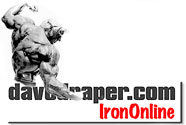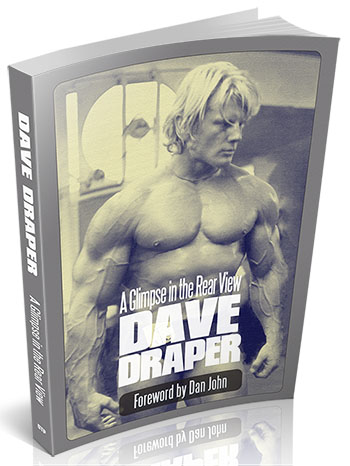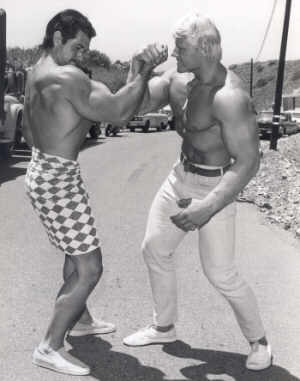Another Imaginative Musclehead with Nothing Better to Do
Like any imaginative musclehead with nothing better to do in the middle of the afternoon, I was sifting through the assortment of exercises I've done over the years. The process reminded me of poking through a pile of nuts and bolts and other evidently valuable hardware collected in a large jar since my childhood introduction to bicycles and wagons. I was searching for a few rare bolts whose threads were yet unstripped and nuts with enough edge to hold a wrench to its task. I was searching for the exercises I had not yet worn out, that had life in them and could be installed in my narrowing routines and added to my "old classics" collection. I was also making notes and discarding some of the heavier hardware that no longer suited my frame. Benches, militaries, reverse curls, upright rows and heavy overhead presses compose the ugly list; do these and pay the mean-faced Reaper of Injury and Pain.
How many different weight training movements there are astonished me when first listing and describing those I recommend in the routines outlined in my book, "Brother Iron Sister Steel." Sixty reasonably standard, non-esoteric exercises fill the seventh chapter, Exercise X-rays. I put my nose closer to the scrap pile and separated out a handful of original basics, popular and productive movements, whose action in the very early days I found dull, restricted and ineffective. Who needed them with the training spectrum replete with bars, dumbbells, pulleys, handles, benches, angles, cams, techno-equipment and other bits of exercise gear? I needed them now. Spiffing up my favorite wagon takes a special application of every unworn, misplaced screw, washer, nut, bolt and indiscernible metal fastener I can scrounge from the old jar.
Of the ten or so exercises I set aside I built my workout for the day. As one does from time to time, I ached generally all over but my energy and desire to workout were dancing. A perfect day, I thought, for experimenting and learning. I'd go easy rather than not at all and possibly teach myself a new trick, maybe an old trick. No pressure, take your time, allow for error, be attentive and play. It's one of those days.
Upper body was the focus with my hands, wrists, elbows and left scapula generating the minor havoc. I begin with wrist curls, my hands wrapped around a thick bar (the 2-inch Apollon's Axle) with the forearms resting atop my thighs; slow reps, light weight carefully assessing range of motion with wrist tenderness as my guide. Warming up with patience and tolerance allows me to proceed in weight and tougher output. Be kind, I say. This apparent isolation movement I notice involves enough bicep contraction and body persuasion that the elbows are slightly bending and loading with a hint of contraction in the muscles crossing the scapula. The thick bar distributes the weight across a broad area of the hand and alters the rotation thereby engendering a different resistance. Sets of fifteen to twenty with a slowly increasing moderate weight suits me in this movement; heavy weight and low reps tend to get me in trouble. I'm in motion.
I continue in my ever-moving multi-set fashion to a thumbs-up curl, bringing the flat of the plate toward the cheekbone. Contrary to my style of using a heavier weight and a mild thrust I stand rigid and pull the dumbbells in tight isolation, flexing all the stabilizing muscles I can locate and command. There's a bunch and they obediently pump if you apply your will, a reward within a reward. I lower the dumbbells to the count of two, if you're counting, and roll my shoulders back, arch my back comfortably, extend my triceps and contract with poised deliberation for two beats and bust into the next rep. Four or five sets of six to eight reps work best to maintain interest and cellular response. This depends on warm-up sets, fatigue factor and so on. The use of lighter weight with magnified concentration and the more complex contribution of subordinate muscles provides deep and effective intensity within the muscles, something I'm coming to depend on to give me more miles to traverse the horizons ahead.
I need a triceps exercise that's not going to cause me to groan as my tender elbows flare. I'm going to learn how to perform bentover triceps kickbacks and then I'm going to learn how to love them. In one hundred years of weight lifting I haven't practiced this common exercise more than six times. I don't like it. It feels like an expression for mules only. However, it doesn't hurt my elbows (not yet). It's one of the few left. You know how they're performed: bend at the waist, hold a dumbbell in one hand, set your upper arm firmly alongside your rigid, horizontal trunk and extend the weight backwards or to the rear by contracting the triceps. Beware of excessive back thrust and elbow hyperextension. Presto. Boring. Probably not so if I yank my stubbornness as my dentist would a foul tooth. I apply myself and seek performance variations to effect burn, pump, mass, shape, form, rhythm... whatever. We'll see. It might be a blast from the past, a buried treasure, an untapped watershed or a wash. I'm as hopeful as a worm hanging on a hook.
The last combination of ordinary yet relatively unpracticed exercises I choose is the preacher curl with one-arm overhead tricep extensions. Preacher curls done vigorously and with full range of motion can be troublesome; tendonitis, over-extension of the elbow, biceps tear, insertion overload and so on. But, if done with moderate weight and within a controlled range of motion that prevents over-contraction at the peak of the movement and hyperextension at the vulnerable extension, the preacher provides excellent healthy muscle action. It's up to you to find the limits and approach them slowly and rhythmically to extract the most from the exercise. Don't do the preacher curl aggressively. Use your might and wits. Enjoy the steady pull and the steady extension. Four or five sets of six or so in the course of your ever-moving, volcanic superset.
One-arm dumbbell extensions are best preformed on a utility bench with a back support. Sit tight with one weighted hand straight overhead. Position your torso and stabilize as needed to execute the extension with the triceps in control. Here, again, you are in charge of determining the most efficacious groove to satisfy your muscular-skeletal mechanics. I found the perfect track that gave me sufficient triceps activity without sending me to the moon was the textbook application; elbows to the sky, slow dumbbell descent till near-ear position and slow, determined return. Crank. With practice I expect to squeeze something worthwhile out of the little rascal.
There's more on my list of last resorts for the long-lasting but that's enough for one workout. I'll save the rest for the end of the month. Meanwhile, don't bail out. We carry no parachutes or ejection seats on the bombers. Draper
Click here for more of Dave's columns
Click here to see more of Dr. Ken in our forum


